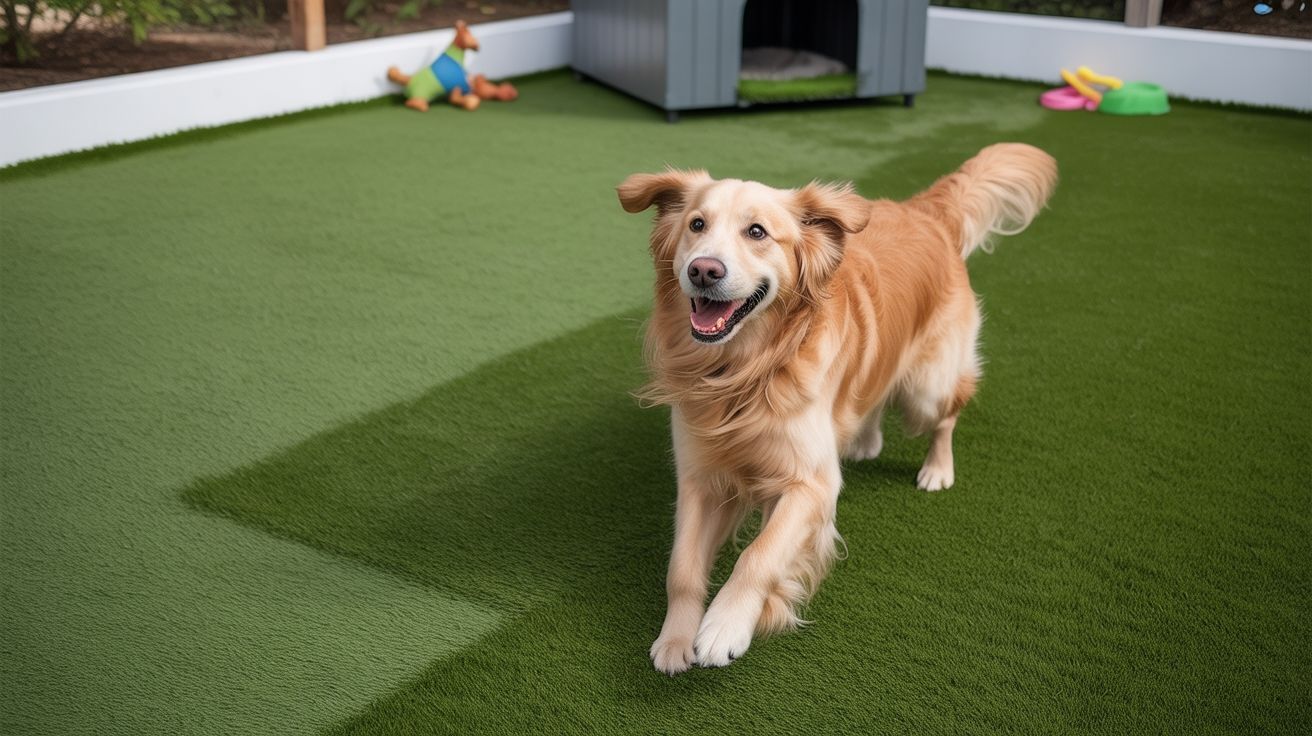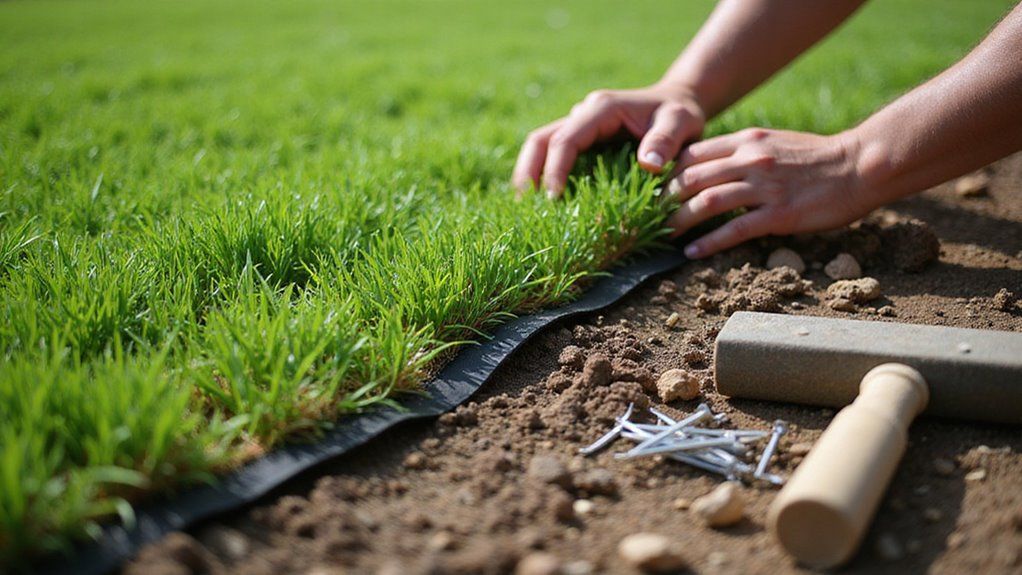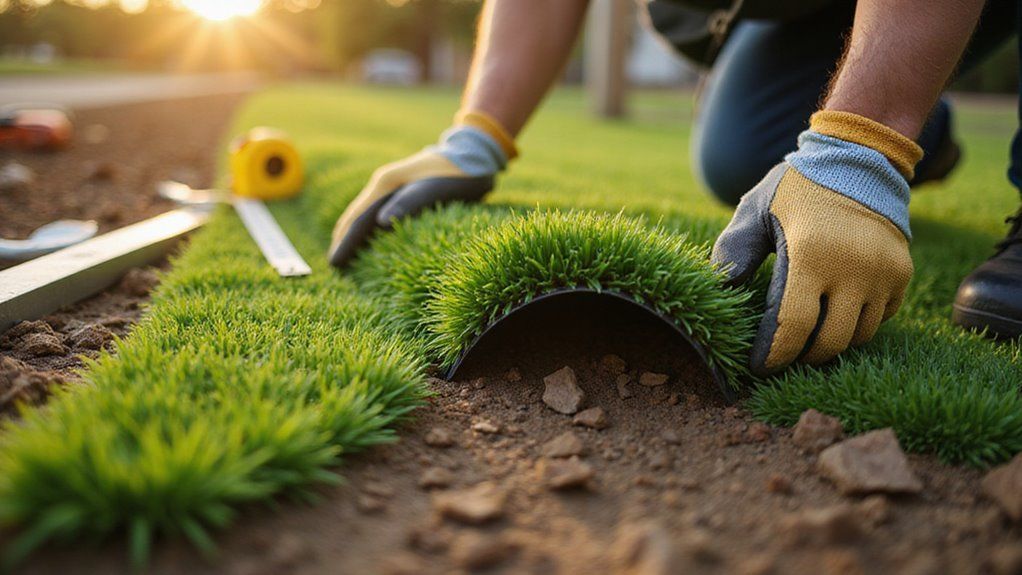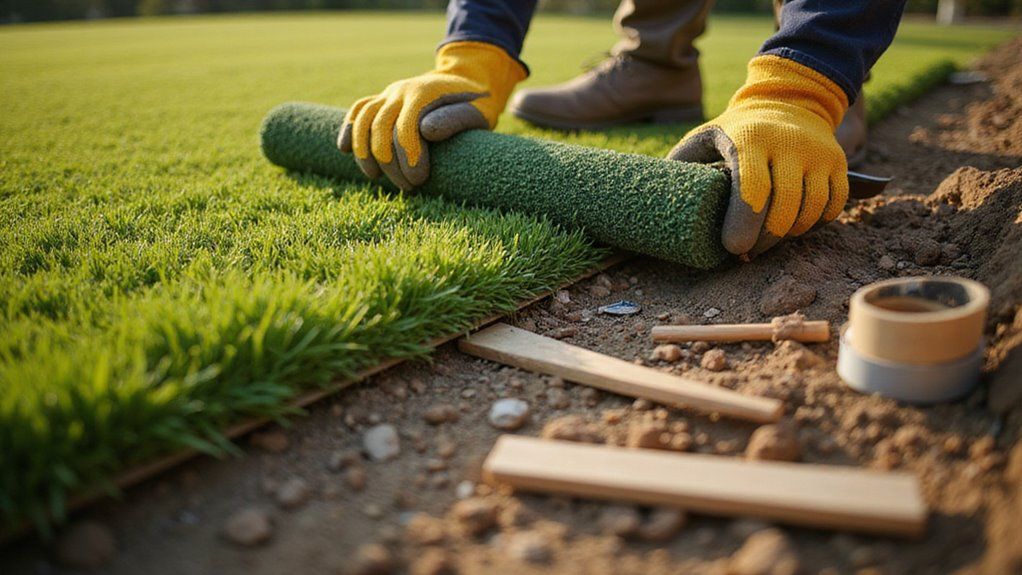Do I Need to Put Sand Under Artificial Grass?
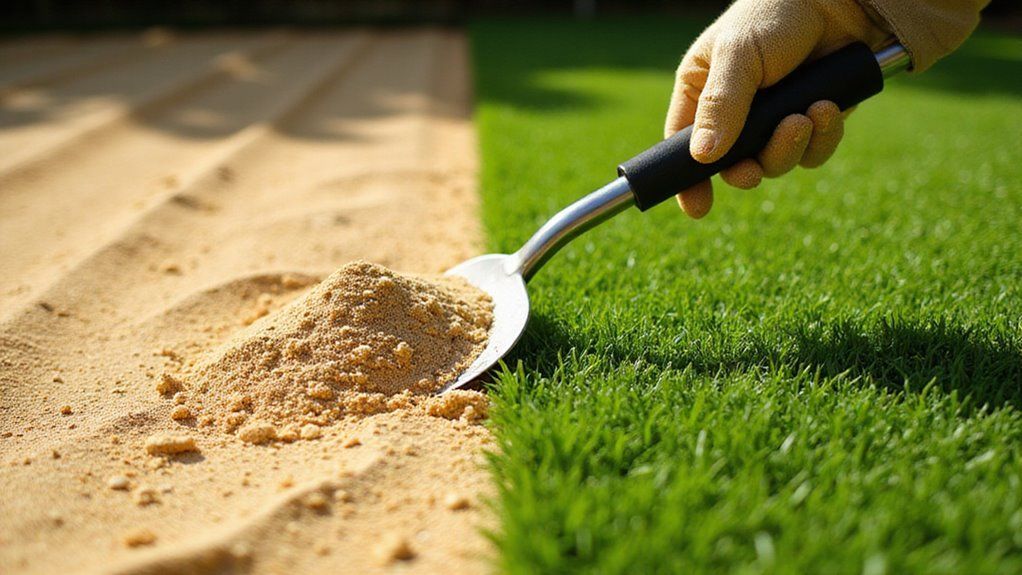
Installing artificial grass can be confusing if you are not sure what goes underneath it. Many people wonder whether sand is truly necessary or just an extra step. The right base affects how your lawn looks and functions in the long run.
If you skip proper preparation, your artificial grass may become uneven, soggy, or even shift over time. Poor drainage or an unstable base can cause headaches and extra costs down the road. Choosing the wrong base can make your investment less durable.
Yes, you do need to put sand under artificial grass for the best results. Sand creates a stable and level base and helps with drainage. Using sand ensures your lawn lasts longer and looks great.
This blog will guide you step by step. You will know exactly how to prepare your base for artificial grass. Let’s solve this together.
Key Takeaways
- Sand provides stability, prevents shifting, and creates a firm, even base for long-lasting, safe artificial grass installation.
- Using sand as a base layer supports proper drainage, helping prevent puddles and soggy spots in your lawn.
- Industry standards recommend a compacted sand layer (15–20mm depth) for optimal support, comfort, and turf performance.
- Properly installed sand infill reduces weed growth, cushions impacts, and maintains a flat, natural-looking surface.
- Skipping sand can lead to uneven surfaces, poor drainage, shifting turf, and a shorter lifespan for your artificial grass.
The Role of Sand in Artificial Grass Installation
Sand is important when installing artificial grass. It helps make the surface stable, drains water, and keeps the grass lasting longer. Without sand, artificial grass may shift or wear out quickly.
Sand creates a flat base so the grass stays even. This helps spread weight and stops bumps or dips from forming. Proper base preparation is essential for effective turf installation, ensuring the artificial grass remains level and minimizes future repairs.
Always use clean, washed sand with no dirt or debris. If the sand has impurities, drainage may be poor and weeds could grow. Odors can also appear if the sand is not clean.
Sand color matters if seams or infill might show. Light-colored sand can keep the surface cooler by reflecting sunlight. Dark sand may change how the grass looks.
If you pick the right sand, the artificial grass will last longer and need less care. Good sand means the grass will handle weather and heavy use better. Proper sand choice keeps the installation looking good for years.
Many experts recommend that the installation process for synthetic grass includes carefully spreading a layer of sand beneath the turf to support drainage and stability.
Types of Sand Commonly Used Under Artificial Turf
The most common types of sand used under artificial turf are sharp sand, silica sand, and crushed granite. These sands are chosen for their stability and support. Each type offers different benefits for turf installation.
Sharp sand compacts well, making the turf surface strong. However, its coarse grains may move over time. If you need a firm base, sharp sand is a good choice. Many installers select sharp sand due to its durability and longevity for artificial turf bases.
Silica sand provides excellent stability for artificial grass. It usually costs more than sharp sand. If budget allows, silica sand offers better turf support.
Crushed granite is an eco-friendly option that drains water well. It can be rough on the turf backing. If drainage is a priority, crushed granite is worth considering.
Select the sand type that fits your project’s needs. Consider compaction, stability, and environmental impact for the best results. Using the proper sand base supports long-term durability and ensures your artificial grass maintains its appearance and function year-round.
How Sand Affects Drainage and Water Flow
Sand controls how well water drains under artificial grass. The right sand lets water move easily through the turf and base. If drainage is good, water will not pool on the surface.
Sharp sand or silica sand works best because of their larger particles. These sands make gaps that help water pass through quickly. If you use sand with too many small particles, water may drain slowly.
Sharp sand and silica sand create larger gaps, allowing water to drain quickly through artificial grass and preventing slow drainage issues.
Fine sand can become compacted and block water flow. This may cause water to collect under the grass after rain. Always use a free-draining stone layer under the sand for best results. By using the proper materials, you also help reduce water consumption, which lessens the environmental impact of maintaining your outdoor space.
A well-graded sand layer helps both filtration and drainage. This setup keeps artificial grass dry and safe to use. If you follow these steps, water will not run off the surface or cause soggy spots.
Using sand not only improves drainage but also helps maintain the long-term durability and pristine appearance of your artificial turf, ensuring it remains a worthwhile investment for your outdoor space.
Impact on Surface Stability and Leveling
The sand layer is important for keeping your artificial grass surface stable and level. If the sand is not spread and compacted evenly, the turf may shift or become uneven.
A good sand base helps prevent bumps and low spots. Using sand also supports eco-friendly practices by minimizing the need for chemical stabilization compounds, making it a more sustainable installation choice.
Proper leveling stops water from pooling and avoids trip hazards. You should use sharp sand to fill in small dips before laying the turf. Compacting the sand with a plate compactor keeps it firm and in place.
Always check that the surface is flat before installing artificial grass. If the base is not level, the turf may wear out faster. Careful preparation helps your grass look and perform its best.
Just as preserving nature for future generations is essential at Hobe Sound Nature Center, preparing a stable base is fundamental for the long-term success of your artificial turf installation.
Enhancing the Feel and Comfort of Your Lawn
You’ll notice a significant improvement in comfort when you use sand infill beneath your artificial grass. The sand provides essential cushioning, making each step feel softer and more natural underfoot. By reducing surface hardness, you create a safer and more enjoyable lawn for everyday activities.
A key benefit of using sand infill is that it helps maintain an even surface, minimizing the risk of twists and sprains while walking or playing. It’s also important to note that regular field maintenance tasks, such as brushing and grooming, help extend the lifespan and performance of your artificial grass.
Cushioning for Softer Steps
The underlayment makes artificial grass feel softer and more comfortable. Specialized pads or a sand infill layer add extra cushioning. These options help spread out impact and create a gentle surface for feet.
If your lawn is for children or play areas, choose quality underlayment for safety. A good base layer can help meet fall safety standards. It also lowers the risk of injury.
Proper underlayment keeps your turf smooth and prevents bumps or wrinkles. Materials like silica sand or foam pads are best suited for artificial grass. They also allow for good drainage and long-lasting comfort.
Reducing Surface Hardness
To reduce surface hardness, use the right infill under your artificial grass. Silica sand is a common choice for this purpose. It helps keep the lawn soft and comfortable.
Sand infill spreads weight evenly and absorbs impact. This stops the turf from becoming hard over time. A softer surface is more pleasant to walk on.
Proper infill also protects the grass blades and stops them from matting. If you choose clean, non-toxic sand, it will not harm the environment. Good infill can help your lawn last longer and stay inviting.
Weed Prevention and Sand Layers
To stop weeds from growing in artificial grass, use a weed membrane before adding sand. The membrane blocks weeds but lets water pass through. A layer of sharp sand makes it harder for weeds to grow and keeps the grass stable.
A strong, UV-stabilized weed barrier should be installed first. This stops most weeds from getting through. If you skip this step, weeds may appear in your lawn. For an example of how nature uses sturdy, natural barriers, take inspiration from coastal habitats at Blowing Rocks Preserve, where erosion is naturally kept in check.
Spread sharp sand evenly over the membrane. The sand creates a firm, flat base for the grass. Minor gaps are filled, making it difficult for weeds to take hold.
Seal the edges of your lawn to block weeds from entering from the sides. This step keeps the whole area protected. If you skip edge sealing, weeds may sneak in later.
Check your artificial grass regularly for any weed growth. Early action makes weed removal easier. If weeds do appear, remove them right away to maintain a neat look.
For inspiration on creating natural landscapes and outdoor spaces, you might consider the lush greenery found at Zeus Park in Hobe Sound, FL.
Sand vs. Other Base Materials: A Comparison
Sand is a common base for artificial grass because it drains well and helps level the ground. Crushed granite, limestone chippings, and MOT Type 1 are also used as base materials. These alternatives give better stability and are less likely to shift over time.
Crushed granite and limestone chippings compact well and keep the surface even. MOT Type 1 is strong and supports areas with heavy use. If you expect a lot of foot traffic, MOT Type 1 is a good choice.
Some natural areas, like unspoiled shoreline, maintain stability and longevity without heavy development, highlighting the benefits of a well-chosen foundation.
Soil type affects your base material choice. Softer soils may need a firmer base like granite or MOT Type 1. Well-draining soils often work well with sharp sand.
Choosing the right base improves the look and life of your artificial grass. If you compare each material’s strengths, you can pick the best one for your needs.
Not all limestone bases are the same; for example, the dramatic limestone formations found at Blowing Rocks Preserve demonstrate how unique limestone can create visually striking and durable surfaces in different environments.
Installation Steps: Where Sand Fits In
To achieve a stable surface for artificial grass, you’ll start by properly preparing the base layer, ensuring it’s compacted and graded for drainage. Next, you’ll spread sand evenly across the area, maintaining a consistent depth to support the turf.
This step is crucial for both longevity and a natural look. When planning your installation, remember that pile height can influence the grass's appearance and feel, so selecting the right artificial grass type for your needs is essential.
Preparing the Base Layer
Preparing the base layer is important for the stability of artificial grass. The base supports the grass and helps with drainage. If you prepare the base carefully, your grass will last longer.
First, remove all plants, rocks, and debris from the area. Use a shovel to make the ground level. If the surface is not flat, the grass may look uneven.
Next, compact the soil with a plate compactor. This step prevents the ground from sinking later. If the soil is not compacted, the grass could shift over time.
Add a layer of crushed stone or gravel for drainage. This material lets water flow away from the grass. Place a layer of sand on top to make the surface smooth.
Install a geotextile membrane before laying the grass. The membrane stops weeds from growing through the grass. If you skip this step, you may have weed problems later.
Spreading Sand Evenly
Spreading sand evenly is important for a smooth artificial grass base. If sand is not spread well, the grass may look uneven. Level sand helps the turf last longer and drain water properly.
Use a drop spreader or shovel to add sharp or silica sand. Spread the sand until it covers the area with a depth of 10–15mm. If you see any bumps or dips, rake the surface to make it level.
Compact the sand with a plate compactor for a firm base. If the sand feels loose, compact it again. A solid sand layer prevents wrinkles and settling later on.
Potential Issues When Skipping the Sand Layer
Skipping the sand layer under artificial grass can cause many problems. The sand layer is important for a stable and long-lasting installation. If you skip this step, your artificial grass may not perform well over time.
The grass may move or become uneven without a sand base. Weeds can grow through gaps, making your lawn look messy. Water might pool on the surface if drainage is poor.
Soil under the turf can shift, causing dips in your lawn. If you want your artificial grass to last, using a sand layer is important. Proper preparation helps avoid these common issues.
Climate Considerations and Sand Usage
Your local climate affects whether you need a sand layer under artificial grass. In rainy areas, sand helps water drain quickly and prevents puddles. Dry regions need sand to keep the turf in place and stop it from moving.
Sand makes the grass blades stand upright, which looks more natural in any weather. It can also help control heat and reduce smells in humid places. If you want the best results, use kiln-dried silica sand.
This type of sand does not hold too much water or become hard over time. A good sand layer keeps your artificial grass strong and neat all year. If you follow this advice, your lawn will last longer and look better.
Pet-Friendly Lawns: Does Sand Matter?
Sand infill does matter when creating a pet-friendly lawn. The type of sand you choose can affect both your lawn’s function and your pet’s comfort. Picking the right infill can make your yard safer and cleaner.
If odor is a concern, look for specialty infills with antimicrobial features. Silica sand alone will not help with smells. Pet-specific infills are better for controlling odor.
Good drainage is important for any pet area. Properly graded sand helps water flow through and prevents puddles. This can also keep bacteria from building up.
Sand infill also helps keep the turf in place. A stable surface means less chance of turf moving when pets play. This makes the lawn safer for running and digging.
Pet safety should always come first. Always choose non-toxic, rounded sand to avoid hurting your pet’s paws. Rounded sand also lowers the risk of accidental swallowing.
Maintenance Implications of a Sand Base
A sand base under artificial grass affects how you care for your lawn. Sand helps with stability and drainage but can move over time. If sand shifts, you may notice uneven spots on your lawn.
You should brush the turf often to keep the sand spread out. Regular brushing helps the grass look even and prevents flat patches. If you see lumps or dips, you may need to add or move sand.
Sand can get compacted, especially where people walk a lot. Compacted sand makes the grass look flat or bumpy. Regular checks let you fix these issues before they get worse.
Weeds do not grow easily in sand, but they can appear at the edges or seams. If you spot weeds, remove them quickly. If you keep up with maintenance, your lawn will look green and neat.
Cost Analysis: Adding Sand to Your Project
Adding sand to your artificial grass project increases the total cost. Sand can help with drainage, stability, and turf life, but it is not always required. If you choose sand, you need to plan for extra spending.
Material costs go up when you buy quality silica sand for the base or infill. Labor charges also rise because more time and skill are needed to install the sand base. If your project is large or far, delivery fees for bulk sand may be high.
Site preparation may cost more if the ground needs extra grading or compaction. These steps can increase your total investment. If you want to keep costs down, review all these factors before making a decision.
Expert Recommendations and Industry Standards
You’ll want to use crushed stone or decomposed granite as the recommended base layer beneath your artificial grass, providing stability and drainage.
Experts suggest maintaining a sand infill depth of 15–20mm for optimal support and fiber longevity. Follow industry installation best practices to ensure a durable, low-maintenance surface.
Recommended Base Layer Materials
Professionals use certain materials as a base layer for artificial grass to make it last longer and work well. The right base layer helps with drainage, keeps the grass stable, and avoids future problems. If you want your artificial grass to look good and last, you need the proper base.
Crushed granite is a popular choice because it drains water well and compacts tightly. Decomposed granite is another good option, especially for home yards, since it is stable and lets water pass through. Crushed limestone works well in areas with heavy foot traffic because it is strong and durable.
Class II road base is a mix of sand, small rocks, and fine particles. This blend is good for places that need to handle a lot of weight. If you pick the right material for your yard and soil, your artificial grass will perform better and last longer.
Proper Sand Depth Guidelines
A compacted sand layer of 20mm to 30mm is best for artificial grass. This depth gives enough support and keeps the surface stable. If you follow these guidelines, your artificial grass will last longer and look better.
Less than 20mm of sand may cause shifting or poor support. More than 30mm can lead to drainage problems and uneven areas. Always use sharp, angular sand for better compaction and strength.
If you want a smooth and strong lawn, stick to the recommended sand depth. Choosing the right depth helps prevent future issues. Proper sand depth is key for a flawless finish.
Industry Installation Best Practices
Industry installation best practices help your artificial grass last longer and look better. These steps make sure your lawn is stable and attractive. Following them leads to a successful installation.
A strong base is important for drainage and support. Use compacted crushed stone or granite as the sub-base. This prevents uneven surfaces and water buildup.
A weed barrier keeps unwanted plants from growing. Choose a permeable membrane so water can still drain easily. Place it above the sub-base before laying the grass.
An even sand layer helps turf fibers stay upright. Spread kiln-dried silica sand at the recommended depth. This improves the grass’s strength and comfort.
Power brushing lifts the grass blades after installation. It also spreads the sand infill evenly. If you skip this step, the surface may look flat and wear out faster.
Paying attention to these details will protect your artificial grass. Your installation will stay neat, safe, and long-lasting.
Conclusion
If you want your artificial grass to last, a sand base is crucial. Without sand, you may face drainage and stability problems. If you skip this step, your lawn might wear out faster.
When you use compacted, sharp sand, your turf stays even and safe. Most experts agree that sand under artificial grass is not just a suggestion. If you want the best results, following this standard is essential.
If you want a smooth, long-lasting lawn, always use sand under your artificial grass. For a professional and reliable installation, choose Install Your Artificial Grass with Synthetic Turf Treasure Coast. Contact us today to get started on your perfect lawn.
About the author
Kathy Leavell
Kathy Leavell is the founder and owner of Synthetic Turf Treasure Coast, a leading provider of synthetic grass solutions for residential and commercial properties in Florida. With over a decade of experience in the industry, Kathy has become a recognized expert in synthetic turf installation, maintenance, and repair. Under her leadership, Synthetic Turf Treasure Coast has earned a reputation for exceptional customer service and high-quality workmanship.
Prior to starting her own business, Kathy worked in sales and marketing roles at several major synthetic turf manufacturers.

